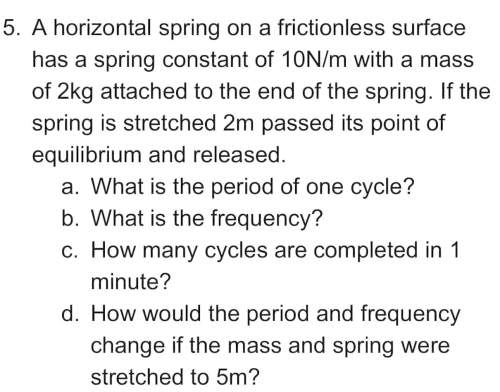
Physics, 05.12.2021 07:00 zariasimone2
A positive charge is 1 m to the left of a negative charge. The positive charge is then moved and placed 1 m to the right of the negative charge. What happens to the electrostatic force between the charges?
The electrostatic force remains attractive, and the magnitude does not change.
The electrostatic force remains repulsive, and the magnitude does not change.
The electrostatic force remains repulsive, but the magnitude changes.
The electrostatic force remains attractive, but the magnitude changes.

Answers: 3


Other questions on the subject: Physics

Physics, 21.06.2019 17:00, emmdolzx
Ajogger accelerates from rest to 4.86 m/s in 2.43 s. a car accelerates from 20.6 to 32.7 m/s also in 2.43 s. (a) find the magnitude of the acceleration of the jogger. (b) determine the magnitude of the acceleration of the car. (c) how much further does the car travel than the jogger during the 2.43 s?
Answers: 2

Physics, 22.06.2019 00:30, powberier6979
Consider an ordinary, helium-filled party balloon with a volume of 2.2 ft3. the lifting force on the balloon due to the outside air is the net resultant of the pressure distribution exerted on the exterior surface of the balloon. using this fact, we can derive archimedes’ principle, namely that the upward force on the balloon is equal to the weight of the air displaced by the balloon. assuming that the balloon is at sea level, where the air density is 0.002377 slug/ft3, calculate the maximum weight that can be lifted by the balloon. note: the molecular weight of air is 28.8 and that of helium is 4.
Answers: 2


Physics, 22.06.2019 04:20, gonzalesalexiaouv1bg
When considering gravity acceleration and the force of acceleration, what must be true? a. the direction of acceleration must be perpendicular to the direction of the force. b. the direction of the force and the direction of acceleration must be the same as each other. c. the direction of the force and the direction of acceleration must be opposite of each other. d. the mass of the body must be the same as the acceleration of the body.
Answers: 1
You know the right answer?
A positive charge is 1 m to the left of a negative charge. The positive charge is then moved and pla...
Questions in other subjects:

History, 24.04.2020 21:56





Mathematics, 24.04.2020 21:56



Chemistry, 24.04.2020 21:56





